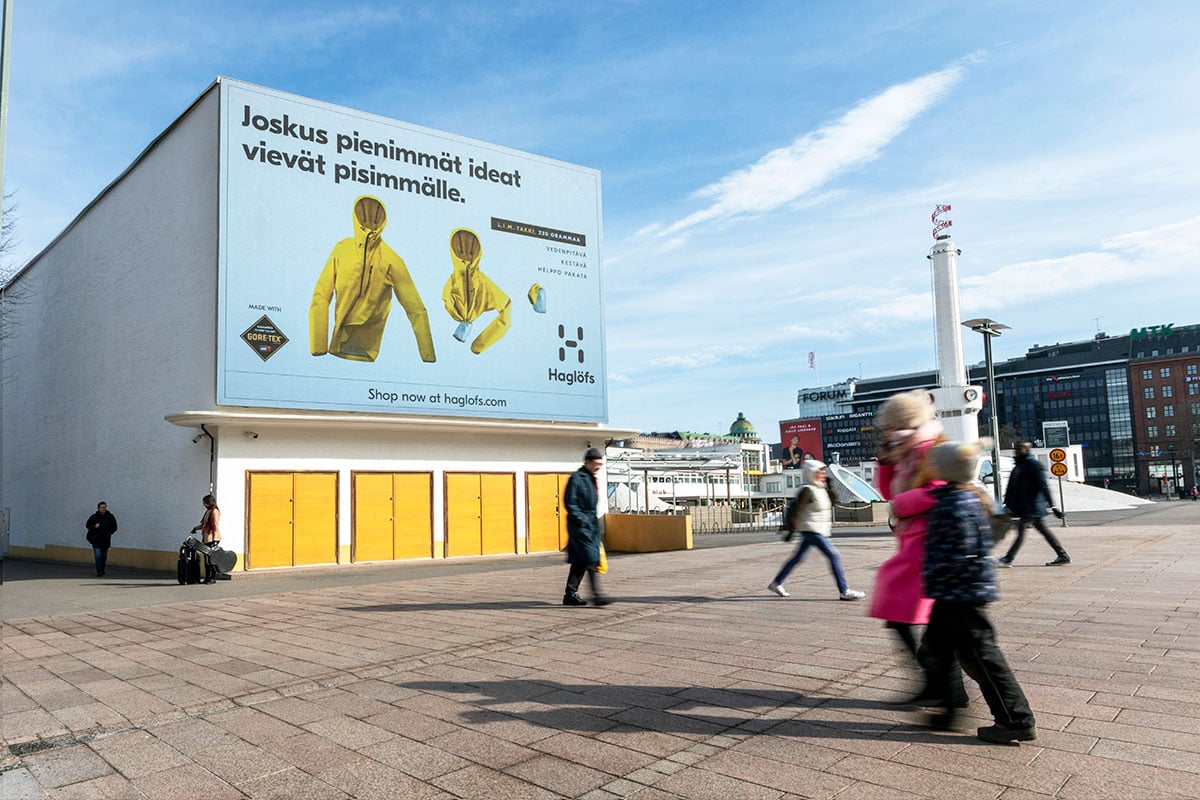
Feb 01 2022 | Consumer behavior, Retail Environment, Research & Insight, Advertising effectiveness
OOH GUIDES TO PHYSICAL AND DIGITAL STORES
The retail sector has seen some significant changes in the past few years, but the COVID-19 pandemic has further accelerated the trend of consumers moving to digital sales channels. It is still unclear how this impacts the advertisers’ marketing strategies, but now it is time to reassess the role of out-of-home advertising in the media selection.
OMNI-CHANNEL MARKETING CREATES RESULTS
Although the traditional commerce in physical stores is still valued, there’s no denying that e-commerce has become a more prominent force in our everyday lives. Already 57% of Finns shop online at least monthly1, and the money spent in e-commerce has grown by 45% when compared to the pre-pandemic times2. In the UK, online purchases already represent one third of total retail sales, which means that many traditional brick-and-mortar operators have been forced to update their strategy by investing in their digital offering. The retail giant John Lewis has forecasted that by 2025, 70% of their total sales will be online and the company has made huge investment into the development of their e-commerce platform in order to improve their competitiveness. Instead of being just a sales channel, the online store is also increasingly valued as a significant driver for the brick-and-mortar store.
Adopting a new kind of business model requires retailers to rethink their media approaches. Although out-of-home advertising is proven to be the most efficient media to guide consumers online3, its role as part of omni-channel marketing may often be overlooked. We recently carried out a study, which looked at the shopping habits of Gen-Zers and Millennials, and discovered that the research and inspiration that influence online as well as brick-and-mortar store purchases are just as likely to come from offline sources as from online sources. Consumers encounter brands in multiple contexts before making a purchase, so companies should prepare a single strategy for physical sales and digital sales – not perceive them as separate silos. Shopping should be made easy for the consumer, regardless of the channel.
AN AUDIENCE-FIRST APPROACH TO OOH ADVERTISING planning
Retailers have often used OOH advertising simply to attract visitors into their stores. After all, this is an effective way to deliver activating messages within a walking distance to the actual store, as OOH advertising has a physical presence on high streets. But, in an omni-channel world, a retailer who only uses one kind of a strategy is missing a huge opportunity to drive online sales too. Instead of focusing on the location of the store, the emphasis should be placed on where the audiences are.
The modern consumer is always-on, and has the flexibility to shop wherever and whenever they like, so why limit communication to the moment when they are in the proximity of the store? At best, OOH advertising can reach almost all Finns within a week4, which means that brands should communicate also in environments where they have no store presence. OOH advertising enables connecting with consumers in the places where they spend the most time, such as local residential areas or when driving home from work. This increases the likelihood that they will commit to your brand and also spend more money on your brand.
By taking an audience-first OOH approach to planning advertising, retailers get to capitalise on OOH advertising’s major strength – building brand equity – which, in turn, increases the effectiveness of any activation measure. A recent long-term study from Dentsu proved that consumers who have seen OOH advertising are 63% more likely to take an online brand action than those who have not seen the advertising. OOH advertising boosts omni-channel advertising campaigns, which on its own is reason enough to include it in the media selection.
UTILISE MEGATRENDS: LOCALITY AND RESPONSIBILITY
Consumers’ increasing interest in different communities opens up new possibilities for out-of-home advertising. OOH advertising can provide a virtual shop window in areas where the company has no physical presence. By using digital out-of-home advertising, advertisers can target their messages directly to local audiences and, thereby, reach potential customers with the right content and in the right moment. Contextually relevant advertisements are proven to increase the emotional connection of the advertisement by 32% and dynamically evolving DOOH advertisements are proven to increase sales by up to 16%5.
One key factor in brand selection is corporate responsibility. A total of 44% of consumers say that they will select a brand investing in sustainable development and 41% of consumers a brand that has undertaken to promote social well-being6. Responsibility affects also the media partner selection: 81% of the advertisement decision-makers feel that corporate responsibility and values represented by the brand have an impact on advertising buying more than in previous years7. The ultimate mission of Clear Channel is to be a Platform for Good, in other words, to provide a platform for brand success as well as to promote general well-being. Advertisers do not select our media to solely introduce their operations, but also to position themselves through their media choice. Out-of-home advertising is a trustworthy, valued and safe channel for brands.
Got interested? To help your brand make the most of Out of Home, please speak to our sales!
SOURCES:
1: Online Shopping Survey. Posti, 2020.
2: E-commerce Index Q4 2021. Vilkas Group, 2022.
3: Online Activation Survey. Nielsen, 2017.
4: Out of Home Generating Online Search. Clear Channel UK, 2021.
5: OOH Weekly Reach in Finnish Population. Kantar, 2020.
6: Webinar: How to influence add-to-cart moments with an in-store digital media channel. Broadsign, 2021.
7: The Future of Commerce. Shopify, 2022.
8: Trust Report. Advertiser Perceptions, 2021.
Primary source of this article: Should retailers rethink the role of out of home? Clear Channel UK, 2021.
Share:







